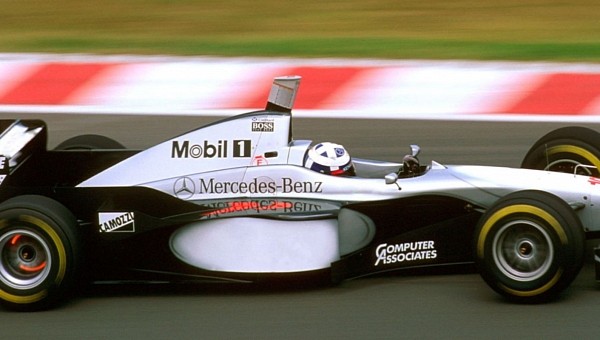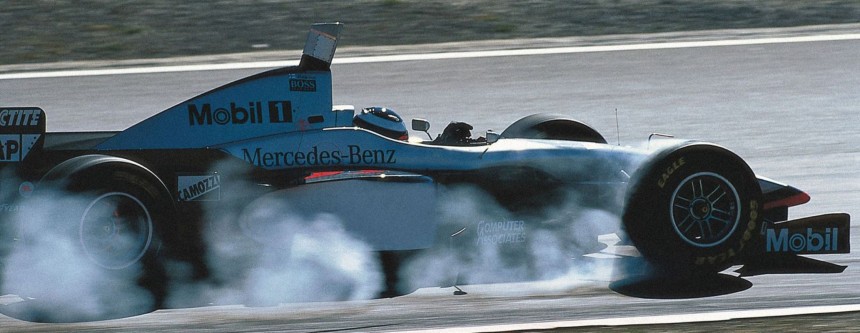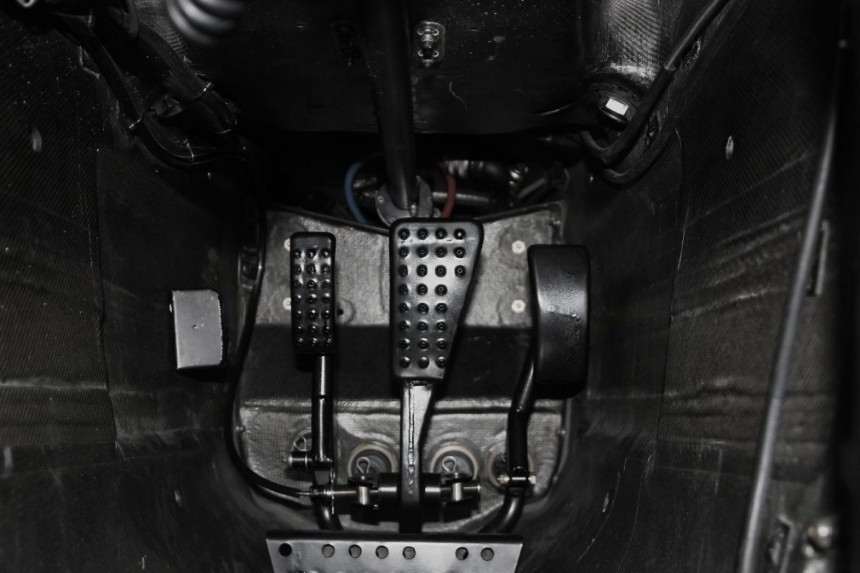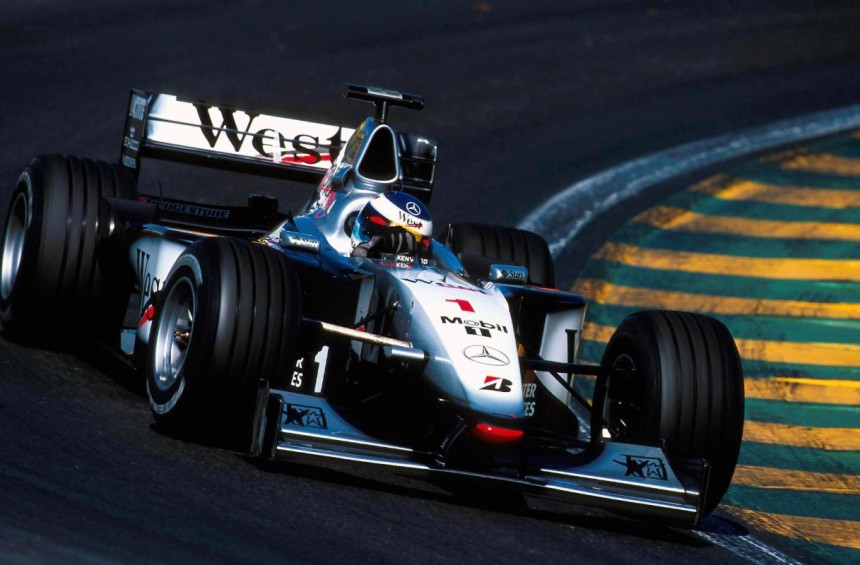As always, in Formula 1, there is a fragile line between cheating and innovation. It was the same thing for McLaren with their genius brake-steer system, an idea so brilliant it was banned. Basically, the McLaren F1 car had two brake pedals.
Today we will talk about how McLaren's innovation from 1997 was so clever it got banned and how the British team drivers Mika Hakkinen and David Coulthard had to change their driving style entirely.
In 1996, McLaren chief designer Steve Nichols was trying to figure out how to make the car quicker. You need to understand that the tires were pretty weird and bizarre at the time. Compared to our era F1 vehicles, whose rear tires are much wider than the front ones, the tires in the late 1990s were very skinny and chunky at the front. As a result, cars struggled with grip at the rear, meaning that the drivers had a harder time on their way out of the corners than on the way in. As a response, the engineers set up the McLaren with a decent amount of understeer in order to protect the rear tires on the exit of the corners.
However, while understeer helps with traction on the exits, you will need to slow the car down more to hit the correct racing line. So what is your solution if you want to protect the rear tires from going out real fast, but at the same time, you don't wish to understeer? Well, Steve Nichols had the answer and came up with a genius solution while apparently in the bath: a second brake pedal that would only break one rear wheel at a time. So, the team decided to try it at a mid-season test at Silverstone.
The funny part is that the system was straightforward and simple. All McLaren engineers did was add an extra master cylinder to the car and a length of brake hose attached from the 'new' pedal to the rear calipers. And as I said before, in a world where tenths of a second cost a ton of money, McLaren gained a lot of time with an invention that probably cost them hundreds of dollars.
When the driver hits the standard brake pedal, it activates all four brakes. However, the difference was when the drivers hit the other pedal. This particular brake would apply more brake pressure to only one of the rear wheels. For example, when Mika or David would enter a corner, they would press the second brake pedal, which would slow the inside tire pulling the car towards the apex and lessening the understeer. As a result, McLaren was much quicker than its rivals through the tight corners. However, the drivers had to be careful with the pedal as it could easily lock the inside wheel, which would give the car sudden oversteer and probably cause it to spin.
Part of the solution, especially on the exit, was for the drivers to press the throttle pedal alongside the extra brake in order to keep the car settled as it stopped the wheel locking up fully. Now, just imagine how hard it is to do that and how much practice you need. You are breaking into the corner at very high speeds, turning into the corner, then you have to press the brake steer pedal while also balancing the throttle just the right amount. That is a lot going on in a short period of time.
The genius solution not only helped correct the understeer issue, but also helped corner aerodynamics as drivers didn't need quite as much steering angle, and so it created a bit more grip in the terms. This system would also help the drivers accelerate away from the corner as well. However, there was one issue with this creation. The system could only be activated on one rear tire, so the drivers had to decide whether they would need help through the left- or right-hand corners.
This innovation had a lot of potential, but as you might imagine, it was a challenging transition for the drivers, especially for David Coulthard, who already had three pedals in his cockpit, as he was using a foot pedal for the clutch. In comparison, Mika Hakkinen had already transitioned to a hand-operated clutch, meaning that Coulthard would have no less than four pedals to control the car.
However, how much advantage did this system actually give McLaren compared to its rivals? Mika Hakkinen was the first driver to test the system, as it was easy to install on his car. On his first run with the extra pedal, he immediately went half a second quicker, which is a considerable margin. As a result, the guys at McLaren were ecstatic because they knew they had found the winning formula for the 1997 season. That year, the British team took their first win since Ayrton Senna in 1993. Unfortunately, after the Austrian Grand Prix, Formula 1 photographer Darren Heath noticed that McLaren's rear brakes were glowing red coming out of corners, which is very unusual when accelerating as hard as possible.
He took his compromising photos to the editor of F1 Racing magazine. As a funny twist of faith, in the following race, the Luxembourg Grand Prix at the Nurburgring, both McLaren cars would retire, one of them right in front of Heath. As a result, he was able to sneak his camera into the cockpit of Mika Hakkinen's car, who forgot to put the steering wheel back on. Darren took the famous photo of the three-pedal vehicle, exposing McLaren's secret. As you might expect, team principal Ron Dennis was extremely nervous.
In the 1998 season, the McLaren system had evolved and developed, and their car had become a front-runner for the championship. For this year, they now had a brake line on both rear calipers, and the drivers could use a switch on the steering wheel to choose which side would be activated in any particular corner. Why wasn't it automatic, you may ask? At the time, the rules said that if the system were automated, it would have been illegal because it would have been an electronic driver's aid.
However, the problem for McLaren was that now everybody knew about their little secret, and inevitably other teams attempted to recreate the system. Still, no one was able to figure out exactly how McLaren did it. And you know how things work in Formula 1. If you can't do something, then try and ban it.
The day before the 1998 season opener in Melbourne, six teams made an official complaint to the FIA (Fédération Internationale de l'Automobile) to get the system banned, but the FIA deemed it legal. At least for that race. After more attempts, especially from Ferrari, the innovation was forbidden after the second race in Brazil. Still, Mika Hakkinen won those two races, helping him a lot in his campaign to win his first world championship.
The crazy thing is that McLaren was not cheating. The system was banned under the banner of four-wheel steering. The British team creation didn't use four-wheel steering because only the front wheels turned. The system only changed the wheel's speed rather than its direction. However, McLaren did a stupid thing and screwed themselves by calling it brake-steer. In addition, Ferrari and other teams put so much pressure on the FIA, and that's how it was banned.
Let us know what you think: was the brake-steer cheating or just very clever engineering?
In 1996, McLaren chief designer Steve Nichols was trying to figure out how to make the car quicker. You need to understand that the tires were pretty weird and bizarre at the time. Compared to our era F1 vehicles, whose rear tires are much wider than the front ones, the tires in the late 1990s were very skinny and chunky at the front. As a result, cars struggled with grip at the rear, meaning that the drivers had a harder time on their way out of the corners than on the way in. As a response, the engineers set up the McLaren with a decent amount of understeer in order to protect the rear tires on the exit of the corners.
However, while understeer helps with traction on the exits, you will need to slow the car down more to hit the correct racing line. So what is your solution if you want to protect the rear tires from going out real fast, but at the same time, you don't wish to understeer? Well, Steve Nichols had the answer and came up with a genius solution while apparently in the bath: a second brake pedal that would only break one rear wheel at a time. So, the team decided to try it at a mid-season test at Silverstone.
The funny part is that the system was straightforward and simple. All McLaren engineers did was add an extra master cylinder to the car and a length of brake hose attached from the 'new' pedal to the rear calipers. And as I said before, in a world where tenths of a second cost a ton of money, McLaren gained a lot of time with an invention that probably cost them hundreds of dollars.
When the driver hits the standard brake pedal, it activates all four brakes. However, the difference was when the drivers hit the other pedal. This particular brake would apply more brake pressure to only one of the rear wheels. For example, when Mika or David would enter a corner, they would press the second brake pedal, which would slow the inside tire pulling the car towards the apex and lessening the understeer. As a result, McLaren was much quicker than its rivals through the tight corners. However, the drivers had to be careful with the pedal as it could easily lock the inside wheel, which would give the car sudden oversteer and probably cause it to spin.
The genius solution not only helped correct the understeer issue, but also helped corner aerodynamics as drivers didn't need quite as much steering angle, and so it created a bit more grip in the terms. This system would also help the drivers accelerate away from the corner as well. However, there was one issue with this creation. The system could only be activated on one rear tire, so the drivers had to decide whether they would need help through the left- or right-hand corners.
This innovation had a lot of potential, but as you might imagine, it was a challenging transition for the drivers, especially for David Coulthard, who already had three pedals in his cockpit, as he was using a foot pedal for the clutch. In comparison, Mika Hakkinen had already transitioned to a hand-operated clutch, meaning that Coulthard would have no less than four pedals to control the car.
However, how much advantage did this system actually give McLaren compared to its rivals? Mika Hakkinen was the first driver to test the system, as it was easy to install on his car. On his first run with the extra pedal, he immediately went half a second quicker, which is a considerable margin. As a result, the guys at McLaren were ecstatic because they knew they had found the winning formula for the 1997 season. That year, the British team took their first win since Ayrton Senna in 1993. Unfortunately, after the Austrian Grand Prix, Formula 1 photographer Darren Heath noticed that McLaren's rear brakes were glowing red coming out of corners, which is very unusual when accelerating as hard as possible.
In the 1998 season, the McLaren system had evolved and developed, and their car had become a front-runner for the championship. For this year, they now had a brake line on both rear calipers, and the drivers could use a switch on the steering wheel to choose which side would be activated in any particular corner. Why wasn't it automatic, you may ask? At the time, the rules said that if the system were automated, it would have been illegal because it would have been an electronic driver's aid.
However, the problem for McLaren was that now everybody knew about their little secret, and inevitably other teams attempted to recreate the system. Still, no one was able to figure out exactly how McLaren did it. And you know how things work in Formula 1. If you can't do something, then try and ban it.
The day before the 1998 season opener in Melbourne, six teams made an official complaint to the FIA (Fédération Internationale de l'Automobile) to get the system banned, but the FIA deemed it legal. At least for that race. After more attempts, especially from Ferrari, the innovation was forbidden after the second race in Brazil. Still, Mika Hakkinen won those two races, helping him a lot in his campaign to win his first world championship.
Let us know what you think: was the brake-steer cheating or just very clever engineering?













